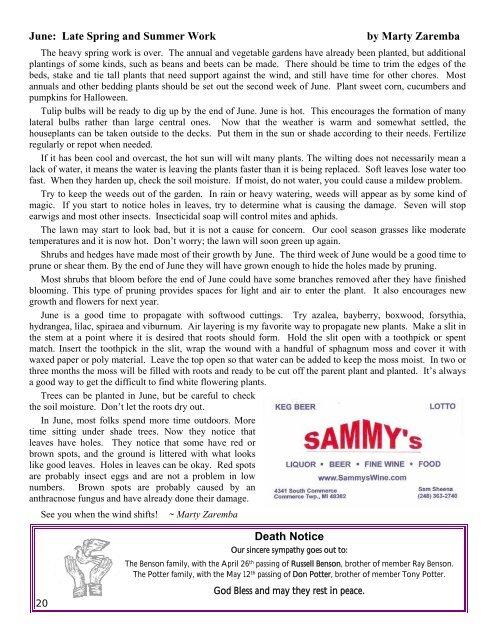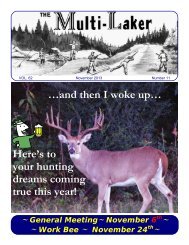Create successful ePaper yourself
Turn your PDF publications into a flip-book with our unique Google optimized e-Paper software.
June: Late Spring and Summer Workby Marty ZarembaThe heavy spring work is over. The annual and vegetable gardens have already been planted, but additionalplantings of some kinds, such as beans and beets can be made. There should be time to trim the edges of thebeds, stake and tie tall plants that need support against the wind, and still have time for other chores. Mostannuals and other bedding plants should be set out the second week of June. Plant sweet corn, cucumbers andpumpkins for Halloween.Tulip bulbs will be ready to dig up by the end of June. June is hot. This encourages the formation of manylateral bulbs rather than large central ones. Now that the weather is warm and somewhat settled, thehouseplants can be taken outside to the decks. Put them in the sun or shade according to their needs. Fertilizeregularly or repot when needed.If it has been cool and overcast, the hot sun will wilt many plants. The wilting does not necessarily mean alack of water, it means the water is leaving the plants faster than it is being replaced. Soft leaves lose water toofast. When they harden up, check the soil moisture. If moist, do not water, you could cause a mildew problem.Try to keep the weeds out of the garden. In rain or heavy watering, weeds will appear as by some kind ofmagic. If you start to notice holes in leaves, try to determine what is causing the damage. Seven will stopearwigs and most other insects. Insecticidal soap will control mites and aphids.The lawn may start to look bad, but it is not a cause for concern. Our cool season grasses like moderatetemperatures and it is now hot. Don’t worry; the lawn will soon green up again.Shrubs and hedges have made most of their growth by June. The third week of June would be a good time toprune or shear them. By the end of June they will have grown enough to hide the holes made by pruning.Most shrubs that bloom before the end of June could have some branches removed after they have finishedblooming. This type of pruning provides spaces for light and air to enter the plant. It also encourages newgrowth and flowers for next year.June is a good time to propagate with softwood cuttings. Try azalea, bayberry, boxwood, forsythia,hydrangea, lilac, spiraea and viburnum. Air layering is my favorite way to propagate new plants. Make a slit inthe stem at a point where it is desired that roots should form. Hold the slit open with a toothpick or spentmatch. Insert the toothpick in the slit, wrap the wound with a handful of sphagnum moss and cover it withwaxed paper or poly material. Leave the top open so that water can be added to keep the moss moist. In two orthree months the moss will be filled with roots and ready to be cut off the parent plant and planted. It’s alwaysa good way to get the difficult to find white flowering plants.Trees can be planted in June, but be careful to checkthe soil moisture. Don’t let the roots dry out.In June, most folks spend more time outdoors. Moretime sitting under shade trees. Now they notice thatleaves have holes. They notice that some have red orbrown spots, and the ground is littered with what lookslike good leaves. Holes in leaves can be okay. Red spotsare probably insect eggs and are not a problem in lownumbers. Brown spots are probably caused by ananthracnose fungus and have already done their damage.See you when the wind shifts!~ Marty ZarembaDeath NoticeOur sincere sympathy goes out to:The Benson family, with the April 26 th passing of Russell Benson, brother of member Ray Benson.The Potter family, with the May 12 th passing of Don Potter, brother of member Tony Potter.20God Bless and may they rest in peace.










